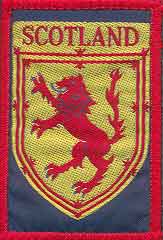Scotland


|
Scotland |

|
|
|
Scotland - May 1985 Vicky Blitz We left England on a tour bus and crossed into Scotland
and the first thing of note was Gretna Green, where the blacksmith used to
marry eloping couples. Then, in Moffat we Back on
the road and on to Ayr, which is Wallace country and the tour guide gave
us a run At Ayr we dropped off those who wanted to do some shopping and the rest of us went on to visit the Culzeau Castle, home of the Kennedy Clan (from whence cometh our late president, John Kennedy). A delightful and feisty old lady showed us the castle and was a show in herself and well worth the price of admission. In Glasgow, we stayed in the elegant Hotel Albany and
toured the city the next day.
We passed through Ft. William where the clans met to sign
their allegiance to the King of England. We bid farewell to the Loch Leven,
where the salt water salmon have adapted to the fresh water of the lake.
We passed the 4,000 foot Ben Nevis, which is often too enveloped in cloud
and fog to see (we were lucky) and left the Great Glen. This is such
picturesque country, one wished to be in a private car to stop often for
pictures. Our tour guide did his best to accommodate our desire for those
stops. We drove along Loch Ness and passed Urquart Castle which was built on the site of Iron Age camp dating back to 200 B.C. The Urquarts unwisely supported Bonnie Prince Charlie and when the British won, they destroyed the castle so it could not be used again. I might add here that we did not see the Loch Ness Monster. We stayed overnight at the Hotel Caledonian in Inverness. Our room was a bit shabby, but never mind, it was clean and had a wonderful view, overlooking the river, Ness. During dinner in a neighborhood bar we watched a little floor show with an accordion player and a Scottish folk singer, which really made one feel one was in Scotland and that we were part of the scene. Comfortable. We had a wee bit of rain and fog, leaving Inverness the next morning. We passed the road to Findhorn, crossed the River Spey, saw a prehistoric stone circle (1800 B.C.) in the distance, a Scottish Castle, and a Celtic Cross. Coming through the Grampian Mountain Range, we were in fog and cloud so bad that our bus driver, Colin, later told us he could only see five or six feet ahead of the bus. The fog was thick like that for at least two hours as he skillfully maneuvered our bus around narrow hairpin turns, with cliffs on one side of the road and a drop-off on the other. We were dismayed that we were probably passing through the most scenic part of the trip and unable to see it.
In route to Edinburgh, we came through Braemar, where they have been having the Highland Games for nine hundred years. Then, thru Perth, on the Firth of Tay, where John Knox preached such a rousing sermon against other religions, the people went right out and burned all the churches in town. And, on across the Firth of Forth to Edinburgh. In Edinburgh, we had a free night but Bob and I opted to
dine in our own hotel, Hotel Mount Royal, and we were glad we did. We had
the best meal of the entire trip. I had roast The following day we found ourselves back on the bus for a city tour of Edinburgh led by a local guide, dressed in his Scottish kilts. We went past the beautiful memorial and statue of Sir Walter Scott and the houses of Robert Lewis Stevenson where he was inspired to write the Lamp Lighter and where he got the idea for Long John Silver and Treasure Island. We also drove past the houses of Simpson (inventor of forceps and chloroform), Sir Walter Scott Lister (antiseptics and Listerine mouthwash), Alexander Graham Bell and the on the Edinburgh Castle which dates back to the seventh century. Edinburgh Castle was a particular delight for me because there was a statue of Wallace, and maiden name is Wallace. The plaque reads:
Memorial to Wallace Pretty cool, eh? And then we were turned over to another guide or docent, in kilts, of course, who took us through the castle and made it's history come alive.
Back on the road again the next morning and on to Melrose Abby. As the story goes, Robert the Bruce wanted his heart to be buried in Jerusalem but the man who tried to take it there got caught up in a war and was killed. So the heart was buried in the walls of Melrose Abby. The Abby, built in 1190, was eventually destroyed in 1542 by Henry VIII when he was trying to force Mary Queen of Scots (a little girl at the time) to marry his son and unite Scotland and England. On to the stately Floors Castle (1721), the ruins of the twelfth century Jedburgh Abby, through the Northumberland National Park and Hadrian's Wall before crossing into England.
A
solitary piper on a lonely hill. V. Blitz
|